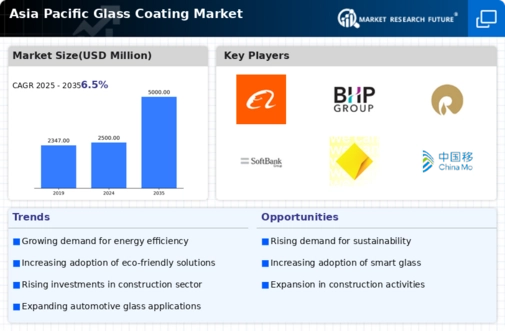Market Trends
Key Emerging Trends in the Asia Pacific Glass Coating Market
The Asia Pacific glass coating market has changed significantly in recent years, reflecting the region's dynamic economy. Significant market developments have been driven by industrialization, urbanization, and the automobile sector. Advanced nanotechnology-based glass coatings are popular. Durability, environmental resistance, and optical clarity are improved by these coatings. As consumers learn about the benefits of such coatings, producers are developing creative ways to fulfill market needs.
Market trends have also been shaped by the Asia Pacific automobile industry. With rising car production and a preference for high-end vehicles, glass coatings with UV protection and scratch resistance are in demand. Thus, regional firms are investing in R&D to develop cutting-edge formulas for the automotive industry.
In Asia Pacific, architectural glass coatings have grown alongside automotive applications. Glass facades are being used more in the construction sector due to rising urbanization and infrastructural development. This increases demand for coatings that insulate, save energy, and protect against harsh weather. As construction becomes more sustainable, eco-friendly and energy-efficient glass coatings are popular throughout Asia Pacific.
Growing environmental concerns have shifted the market toward water-based glass coatings. Lower volatile organic compound (VOC) coatings are preferred as regulations tighten and customers grow more ecologically sensitive. Manufacturers and end-users prefer water-based formulations because they handle these issues and dry faster.
Strategic industry relationships are another trend. Companies recognize the value of synergy to use one other's technologies, distribution networks, and market presence. Collaborations help generate more extensive and competitive product portfolios by sharing information and skills.
Market growth may be hindered by raw material price fluctuations and economic conditions affecting consumer spending. Asia Pacific's economic vitality and pursuit of technology improvements keep the glass coating business resilient despite these hurdles.










Leave a Comment